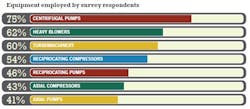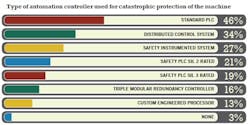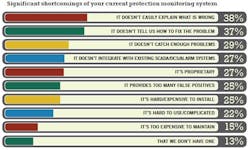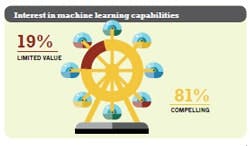Improving performance and uptime of heavy rotating equipment
ARC Advisory Group and Plant Services recently conducted a survey targeting manufacturing operations that rely on heavy rotating machinery in a power capacity range of 200 HP to 30,000 HP. This includes heavy-duty pumps, turbomachinery, centrifugal pumps, axial compressors, reciprocating compressors, and blowers that are either used in production operations or are critical to safety.
Sal Spada, Research Director, has been with ARC Advisory Group (www.arcweb.com) since 1997. His focus areas include general motion control, material handling, machine safeguarding, computer numerical controllers, robotics, and servo drives. Sal’s professional background includes software development, project management, and product marketing. He holds both a B.S. and an M.S. in Electrical Engineering from the University of Massachusetts with a concentration in Adaptive Control Systems. He also holds an M.B.A. from Babson College. Contact him at [email protected].
The performance and uptime of heavy rotating equipment play an important role in business profitability in industries such as oil & gas, mining, and chemicals, and in safety for the power generation industry. However, capital-intensive industries dominate the use of these types of equipment. One of the most important metrics used in these operations is return on capital employed, which depends in large part on the availability of rotating equipment. Based on the response from our survey participants, over 80 percent of the respondents target 90 to 95 percent availability of the equipment.
Machine builders and manufacturers employ a wide variety of methods to achieve this level of availability. The purpose of this survey was twofold: 1) identify current industry practices to reach the target availability; and 2) identify the layers of protection incorporated in machinery for predictive maintenance, diagnostics, and failure analysis purposes.
Survey goal, approach and responses
ARC designed and hosted the Web survey, which solicited participants via emails from Plant Services and ARC. Between February 2015 and June 2015, we received 67 valid responses that subsequently were used in the analysis. All respondents received the final survey report.
This survey sought to identify gaps in the capabilities of currently available machine automation equipment, such as AC drives, programmable logic controllers (PLCs), and safety systems, used to implement layers of protection to detect imbalance, cavitation, vibration, and other abnormal operating conditions. The survey also identified specific technological innovations that are being employed closer to the edge of the machine control to improve layers of protection and availability with automation solutions, intelligent sensors, embedded advanced control algorithms, and predictive condition monitoring.
The roles of the respondents were: 40 percent engineering managers, 31 percent engineers, and the remainder asset managers from a wide range of asset-intensive industries. In terms of the types of businesses represented, owner/operators of machinery accounted for 50 percent of respondents, system integrators accounted for 26 percent, and the rest were either an OEM machine builder or an automation vendor. Combined, over 40 percent of the respondents were from the oil & gas exploration and power generation industries. A second tier of industries, which included cement & glass, electronics & electrical, chemical, refining, and food & beverage, combined to account for 35 percent of the respondents.
Automation for control and protection
Respondents were asked what types of automation is currently used to control the machine and prevent catastrophic failure. PLCs were used as the standard machine control in over 75 percent of the cases. Proprietary systems ranked second, while AC drives with an integrated PLC ranked third.
When implementing a layer of protection, the PLC continued to be the solution of choice; however a distributed control system (DCS) was employed over 36 percent of the time. Combined, SIL 2- and SIL3-safety rated PLCs was employed over 40 percent of the time. We interpret these results suggest that over 40 percent of the rotating equipment employs a secondary safety controller that has a SIL rating in addition to non-SIL-rated automation system. Essentially, machine builders use safety certified controllers to ensure that machines are shutdown in an orderly fashion to prevent a catastrophic event.
Sensors that identify impending catastrophic operating conditions
Imbalance, cavitation, vibration, and insipid surging often indicate impending catastrophic conditions. Rotating pumps, which include axial, reciprocating, and centrifugal, were the most dominant types of rotating equipment used in operations. Vibration was the most common operating condition identified by automation systems that could lead to a catastrophic event. Cavitation ranked as the least-used indicator, whereas insipid surging and imbalance were used equally often.
While vibration ranked as the most dominant operating condition that could lead to a catastrophic event, over 70 percent of the machines employed accelerometers, vibration sensors, and temperature gauges. When respondents were asked how their control system handled less-than-catastrophic operating conditions, the overwhelming response was to invoke a controlled shutdown. However, 40 percent indicated that the system adjusted control system parameters and 29 percent simply reduced the output. We assume that machine controllers are anticipating or reacting very quickly to cavitation and insipid surging and are not classifying these as catastrophic events, and that under these two conditions many machine controllers will adjust the control system parameters or reduce the output of the machine.
Auxiliary protection monitoring systems
Based on interviews with several OEM equipment producers, there appears to be a measurable gap between the capabilities of machine builders and what some leading industrial organizations are seeking. This creates a productivity and performance gap.
While rotating equipment suppliers are incorporating condition monitoring, predictive maintenance, and safeguarding technologies into the systems, these tend to be relatively conservative implementations. For the most part, failure analysis and predictive maintenance solutions embedded in machinery are generally limited in capability. The solutions rarely correlate information from multiple sensors. Furthermore, many equipment vendors do not appear to understand the full potential of the equipment. As noted earlier, most machine builders/system integrators employ off-the-shelf PLCs and AC drives (some with embedded PLCs) to control and monitor the machinery. These systems simply do not have the computational capacity needed to implement advanced predictive maintenance and failure analysis algorithms.
Less than 45 percent of survey employ an auxiliary performance management system. Even those respondents that have used auxiliary performance management systems expressed relative dissatisfaction with the ability of the systems to help them identify the root cause of the problem. Over 40 percent of the respondents indicated that these systems could not tell the operator the actual machinery problem, while 25 percent stated that there were too many false positives. Almost 37 percent stated that these systems could not tell the maintenance staff how to fix the problem. About 25 percent said that the systems were too complicated to interpret results, often leading to disuse.
For noncritical maintenance issues, maintenance personnel making rounds is employed in more than 66 percent of cases, but auxiliary vibration monitoring systems rank second in the survey with over 54 percent of the respondents. More complex solutions using multivariate analysis rank third with over 38 percent of the respondents, indicating that respondents use systems with this capability. It appears that that many of the protection measures being used today are after-market solutions and not designed into the machinery.
Machine learning is the ideal case
Ideally, a performance monitoring system has machine learning capabilities. A final survey questions asked, “Imagine a hardware and software system capable of automatically measuring and analyzing machine performance continuously, allowing the system to learn and adapt to individual motors and predict future maintenance requirements well in advance of a motor or component failure. How compelling does this seem versus existing available solutions?”
Overwhelmingly, respondents responded positively to the possibility of machine learning systems that can adapt to system variations. Nearly 43 percent of the respondents found this as a “highly compelling” proposition. In the end, manufacturers want to use intelligent systems that can remove the human element from the decision making process.








